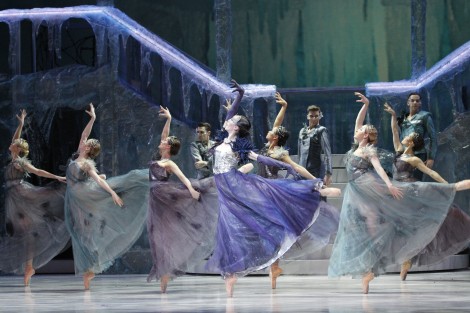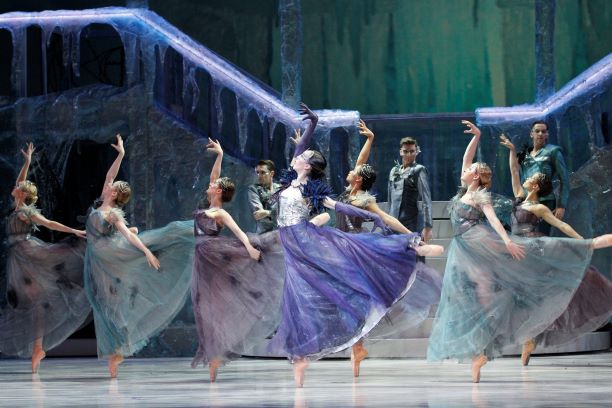10 December 2011, Opera Theatre, Sydney Opera House
Graeme Murphy’s Romeo and Juliet for the Australian Ballet continues to generate discussion and mixed reviews, and I recently took a second look at it at a Sydney mid-season matinee performance. It is impossible to ignore the dominance of the scenic elements and the challenges of the constantly changing times and locations, and why should we ignore them anyway as they are an intrinsic part of the collaboration and choreographic plan. So I still like to see this Romeo and Juliet as a postmodern work, despite all the problematic issues that the term ‘postmodern’ generates. Postmodernism, at least in areas of the visual arts, allows a collage of non-sequiturs and apparently frivolous allusions, which gives a pastiche we can either love or hate, but not ignore.
On this viewing, the sometimes overbearing scenic elements, and the episodic nature of the changes of time and location, did not startle to the same extent as they did that first time. On any second or subsequent viewing, whatever the work, one naturally notices different things. During the opening scene, set in what my ever-entertaining companion at these matiness thought looked like a scene from Dungeons and Dragons, it was Murphy’s attention to detail in his handling of the minor characters that attracted my attention. At the side of the main action and above it on the ‘bridge’, groups of bedraggled-looking townsfolk engaged in their own comments on the feuding being carried out centre stage. Murphy has always been a dab hand at this kind of background action—no standing round twiddling thumbs and admiring dresses. His works are choreographed down to the last detail.
The ball scene contains one of the best-known sections of the Prokofiev score, a section I will never be able to call anything other than ‘the cushion dance’. My approach to this scene will forever be coloured by my very first viewing of a ballet with the name Romeo and Juliet when, as a child, I saw a film of the Bolshoi Ballet with Galina Ulanova as Juliet. Well there were no cushions for the male guests to toss onto the floor in Murphy’s version of the magnificent ‘cushion dance’, but there was some startling and bold choreography. I especially admired the dramatic swirl of movement as the male guests held their partners, who leant back precariously as they were turned in a tight circle and who, with knees bent and feet together, jabbed the floor aggressively with their pointe shoes.
Akira Isogawa’s wedding dress for Juliet in the Japanese-inspired scene also caught my eye. Although it is pretty much impossible to learn much about the construction and detail of individual costumes from a seat in the auditorium, this dress seemed to be beautifully made from delicately patterned silk, or synthetic silken-look fabric. But it was the shoulder feature that surprised me. The straps that held the dress together over the shoulders were wide and crossed over just as they joined the bodice rather than in the middle of the of the upper back. It was a simple and almost unnoticeable touch, and perhaps not of major significance in the overall scheme of the ballet, but so elegant.
I was lucky enough to see Juliet Burnett in the leading role on this second viewing. She handled Murphy’s ever-changing and ever-challenging choreography as if she were born to dance his steps. She was bubbling with youth as she ran across the stage on pointe in the opening sequence. She soared through lifts in Murphy’s pas de deux and in those scenes in which the black-garbed holy men transported her across the stage. Her expressive arms gave a joyous quality to those moments where her young love for Romeo needed to be shown. But those arms also conjured up something entirely different, something leaden and full of fear when, for example, she reached out in an attempt to pick up the bottle of poison from her bed. It was this quality of being able to express emotion so well through the body, and not just through facial expression, that made her performance so exhilarating. But perhaps most of all it was a thrill to watch her portray the character of Juliet and to maintain that characterisation across the entire ballet, despite the changes of time and location. A stellar performance from Burnett who was partnered by Rudy Hawkes as Romeo.
Of the other cast members, Josef Brown made a welcome return to the ballet stage as Lord Capulet with Ingrid Gow as his Lady Capulet. Brown played Lord Capulet with a calm yet imposing presence. His handling of Juliet in the scenes with Paris rarely showed anger but rather some kind of fatherly determination. It allowed Murphy’s choreography, which in these scenes contains conflict within it, to shine through.
Michelle Potter, 11 December 2011
Featured image: Artists of the Australian Ballet in Romeo and Juliet, 2011. Photo: © Jeff Busby. Courtesy of the Australian Ballet

Here is the link to my original post and comments on this production of Romeo and Juliet.
UPDATE, 12 December 2011: I have just reread more carefully the original post written after opening night in Melbourne in September. In it I wrote: ‘Manion’s strongest contribution [Gerard Manion was the set designer for this work] was a visually arresting painted front cloth comprising a huge bunch of gold, pink and blood red lilies from which the deepest colours drained to grey as the cloth rose at the beginning of the work’. Well this was not part of the Sydney production! Why not? I have no idea, but it was a sad omission in my opinion.

It’s good to hear thoughts from Michelle’s second viewing of this production. I am still awaiting a friend’s copy of the broadcast from the Studio channel for my second thoughts since its Melbourne debut season. Her friend’s “Dungeons and Dragons” characterisation of the opening scene perfectly sums up the trivial nature of the whole enterprise for me. I have had to see dear friends near the end of their lives both at home and in hospices and I have never felt that Darkness/Death could be anything like handsome Adam Bull stalking the stage done up like a refugee from a Milan catwalk. And jabbing the floor with pointe shoes and making clawing gestures with the hands seems a too easy way of characterising the enmity between the warring families. And oh for a professional theatre designer who can design costumes that can be read in the whole theatre not just in publicity shots and by spectators in the front row.
Anyhow, I look forward to being able to reconsider my feelings when I can view the TV broadcast. I do remember being apoplectic when “Le Concours” first appeared here but over several perfs and a revival I came to appreciate it.
It’s equally as good to have another comment from Adrian! My friend felt the same as Adrian about the warring families and the way the conflict was expressed choreographically. I didn’t mind it and in fact found that it was quite powerful this second time around. The Prince of Darkness on my second viewing was played by Brett Simon and for me he wasn’t as strong as Bull but I liked the character just as much this time. It is an effective ‘through line’ although needs exceptionally strong charatcerisation for it to come off, which it did for me in Melbourne but not so much in Sydney.
Adrian’s comment about the designs is a good one though. I have a much better seat in Sydney (where I subscribe) than the one I am occasionally given as a reviewer in Melbourne. And the SOH has much better sightlines in my opinion than the State Theatre. But even from my Sydney advantage (not the front row though!!) it was not easy to read the costumes, which is why I guess I was thrilled to discover something as pleasing as the wedding dress.
The bulk of traffic across this website has just recently moved from Melbourne to Sydney and the original post relating to R & J is top of the pops once more. This has been clearly in evidence from the day after the Sydney opening night. And although Sydneysiders have been more reticent (practically silent really) about commenting, the statistics indicate that the interest in this show is there nevertheless and is as strong as it was in Melbourne. In the end we can only be enthusiastic that this ballet is creating such interest.
What the cast sheet for that matinee didn’t say (and this annoyed me) was that it was both Juliet Burnett’s and Rudy Hawkes’ debut in their respective roles. Which to my mind makes it an even better performance.
I saw 4 performances in Melbourne, and 3 in Sydney, as I like to see all casts if possible. The casts I saw twice were Daniel Gaudiello/Leanne Stojmenov and Kevin Jackson/Madeleine Eastoe. I sat in various stalls seats in Melbourne, stood in the circle twice in Sydney, and sat in the circle once in Sydney.
I do wish designers and choreographers would remember that half or more of the audience is sitting above the stage, because effects that are amazing from the stalls are either invisible or somewhat risible from circle and/or balcony.
The Juliet who, for me, most conveyed Shakespeare was Leanne Stojmenov.
I agree with you on your point about designers. I interviewed Jennifer Irwin recently and she talked about her work for the Opening Ceremony at the Sydney 2000 Olympic Games. She remarked on the difficulties she faced in designing wardrobe items that, in the case of the Olympics, needed to be read from the back row of a vast stadium as well as by a TV audience who would often be getting close-up views. It’s something every designer could think about as you are right, sitting (or standing) at the back of the circle is vastly different from a good seat towards the front of the stalls.
I was surprised when I got hold of Jeff Busby’s image of dancers in the ball scene, posted above, to see the detail on the shoulders of the dresses, which I could then link back to something Akira Isogawa was saying on one of the many YouTube clips relating to this Murphy R & J. Isogawa kept talking about adding ‘thorns’ to the costumes and when I saw the Busby shot it finally struck me what he was talking about and what he was trying to do.
Thank you for your comment.